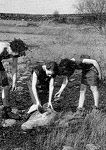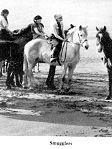|
Jean Hay of Maybole has provided the programme below, published for the Coronation Pageant, held in Maybole on Saturday 30th May 1953. The programme was scanned and converted to text and images by Jim Millar. Click on the images below or use the scroll bar of your browser to view the pages following the table. Pages 1 - 8 │ Pages 9 - 18 │ Pages 19 - 28 (photos) │ Pages 29 - 38 │ Pages 39 - 49 │ Advertisements |
||||
 |
 |
 |
 |
 |
| Nineteenth Century |
Nineteenth Century |
Nineteenth Century |
Monks of Crossraguel | Countess of Cassillis and Johnny Faa |
 |
 |
 |
 |
 |
| Crannog Dweller Loch Spoats |
Smuglers | Maybole Castle | "Firefly"- Carrick Sailing Club | Mass Emigration |
|
give excess to the railway station, which had been built 16 years before. In 1886, on Mr McCubbin's death, his son, John, came home to help his mother. He was mainly interested in the hiring side of the business, with the result that he soon had about thirty horses for pulling brakes, waggonettes and carriages. Excursions became very popular, and the King's Arms soon acquired a great reputation among the West of Scotland hostelries, running regular four-in-hand sightseeing excursions to such beauty spots as Loch Doon, Tairlaw Linn and Maidens. It was also a favourite place for lunch for tourists from Ayr, who came the country road and returned by the shore road. It was a common sight to see forty Ayr horses, being attended to by the seven or eight ostlers during the luncheon halt. Good accommodation was also provided. Wordsworth, Keats, Dante, Gabriel, Rossetti and Robert Louis Stevenson all stayed in this hotel while exploring the neighbouring country. MAYBOLE in the NINETEENTH CENTURY Extract from Carrick Directory, 1883 THERE are not fewer than eight shoe factories in the town, three of which have large tanneries and currying establishments connected with them; and the number of their workers, with the amount of their average production per week, may be thus tabulated:
To dispose of this immense stock, the Maybole Shoe Manufacturers have established a whole network of shops throughout the country, from John o' Groat's to Maiden Kirk, and even beyond it, for they have invaded both England and Ireland. People have often - 19 - |
|
wondered why the shoe trade should have taken root so vigorously here, but the secret lies in the skill and enterprise of the manufacturers, who have availed themselves of the most recent improvements to keep abreast of the age. Another trade in which Maybole has won for itself a name is the manufacture of agricultural implements. Here Messrs Jack and Sons and Mr Thomas Hunter, have become deservedly famous. Their collections are to be seen at all our large agricultural shows, and the medals they have won would almost stock a small jeweller's shop. The weaving trade, for which this district was once famous, has now almost departed, although a spirited attempt to revive it is at present being made by the Messrs Murdoch, of the Red Lion Factory. The town is supplied with gas and water, but the latter having proved insufficient, a further supply is being brought this present year from Loch Spoutsa distance of 31/2 miles. The cost of the undertaking is estimated at £5,325 The Public School was opened in 1876, and contains accommodation (which is hardly sufficient) for 650 children. The Poor's House was built in 1864, and has accommodation for 48 inmates. It belongs to the parishes of Maybole, Kirkoswald, Kirkmichael, Girvan, Dailly and Barr. The town has also a Fever Hospital for cases of infectious disease, but it is generally empty. There are six churches in Maybole two belonging to the Established Church, a Free Church, a United Presbyterian, an Episcopalian, and a Roman Catholic. There is also a Hall for Evangelistic purposes, and a body of the Plymouth Brethren. The town has two banks to minister to its financial wants, and a respect able Railway Station has recently been granted in token of increasing traffic. Thursday is understood to be our Market day, although this is now of little importance. There are two Fast-days held annuallythe Wednesday before the third Sunday of April, and the Wednesday before the last Sunday of October. There are also two Fair-days annuallythe third Thursday of April and October. The town of Maybole is situated on the face of a rising ground overlooking the pleasant valley of the Girvan. It is 9 miles from Ayr, 12 from Girvan, and 3 in a direct line from the sea. The parish is of considerable extent, stretching away to the mouth of the Doona distance from the town of about 7 miles. It includes within its limits many gentlemen's seats, with the villages of Minishant and Dunure. Minishant is 3 miles from Maybole, and is famed for the manufacture of Scotch blankets. There are two - 20 - |
|
factories hereone carried on by Mr James Limond, and the other by Messrs A. and J. Limond. It is a pleasant village, with a remarkably neat church, erected in memory of Lady Coats. Auchendrane, the seat of Sir Peter Coats, is close at hand, and is a handsome specimen of the old Scottish Baronial Castle, overlooking the "bonnie Doon". Dunure village is 6 miles from Maybole, and is inhabited entirely by fishermen. Near it is the ruins of Dunure Castle, the ancient seat of the Kennedys who have now removed their residence to Culzean. SchoolsDuring the period of industrial expansion, schools were also developing. After the Union of 1707, the success, in England and the then expanding Empire of many Scots, was itself a tribute to the Scottish Schools, which even before that date had gained a high reputation, extending far beyond the country's borders. This result was achieved not only by the skill and industry of teachers, but also by the application of pupils, which was due in no small measure to the importance attached by their parents to the work of the school. This permitted men and women of vision, such as the Fergussons of Kilkerran, who have done so much to develop the schools in Maybole, to turn their far-sighted ideas into facts. There are to-day three schools in MayboleCarrick Academy, Cairn Primary School and St. Cuthbert's Roman Catholic School. Carrick Academy is a union of three schools. (1) The Parochial School of Maybole which probably originated before 1560. (2) The West Church School, known also as Carrick Academy or the Whitehall School, founded about 1845 by Sir Charles D. Fergusson. (3) Mr Alexander Fergusson's School, taken over in 1846 by the Free Church (later Cargill Church) and known as Dangartland or Society Row School, and later as the Female Industrial School. In 1876 all these schools united under the name of Maybole Public School, changed in 1891 to Maybole Ladyland School, and in 1905 to Maybole Carrick Academy. Cairn School, which was completed in August, 1890, was not given individual status until October of that year. It was officially opened on the third of November. 1890, and during the first week enrolled 196 boys and 144 girls. The Roman Catholic School was opened in 1878, at the same time as the Chapel, containing the magnificent red granite arch. (Continued on page 28 below) - 21 - |
|
Pages 22 - 27 are photographs. See the table at the top of this page to view them. |
Mass EmigrationSoon after the beginning of the 20th century, owing to a decline in the boot and shoe trade, prospects were poor. As a result between 1907 and 1912, between one and two thousand people left the town, many going to Canada. To transport the large numbers on the first stage of their journey, special trains were run. First World War and Formation of The British Legion Although Maybole had suffered very heavy casualties in the Boer War, the townsfolk again rallied to the colours in 1914. This was not surprising as the town has a fine war record, being closely connected with the Cameronians and the Ayrshire Yeomanry, The Earl of Carrick's Own. The Earl of Carrick is the oldest Scottish title, and is held by the heir to the throne. When, after the end of the war, Earl Haig visited Culzean, he formed "The British Legion" which rapidly spread throughout the country. Between the Wars ((1918-1939) Maybole suffered severely from the world trade depression, which followed the war of 1914-1918. It was during this period that Messrs Jack and Sons, as agents for Dunlop Rubber Co., fitted rubber tyred wheels to farm carts. This was the first firm to do so in Scotland, and the fact that this type of wheel is to-day commonplace is striking proof of "Jack's" foresight in 1932. The Second World War ((1939-1945) In the Second World War many Maybole men again played their pair. One of the most renowned of Carrick men is Lieut. -Col. Bernard Fergusson, D.S.O., O.B.E., of Kilkerran, who gained world fame for his daring exploits with the Chindits. President EisenhowerAt the end of this war the freedom of the town was bestowed upon the famous leader of the victorious Allied Armies, who, as President Eisenhower of the U.S.A., has now an unsurpassed post of responsibility. Maybole in 1953Maybole is the centre of a thriving farming community, famous for its early potatoes, and T.T. herds, and enjoying a high standard of living. Jack's, the implement makers, and Hutchison and McCreath, the grain and fertiliser merchants, supply their specialised needs. Both of these firms also trade far beyond the borders of Ayrshire. - 28 - |